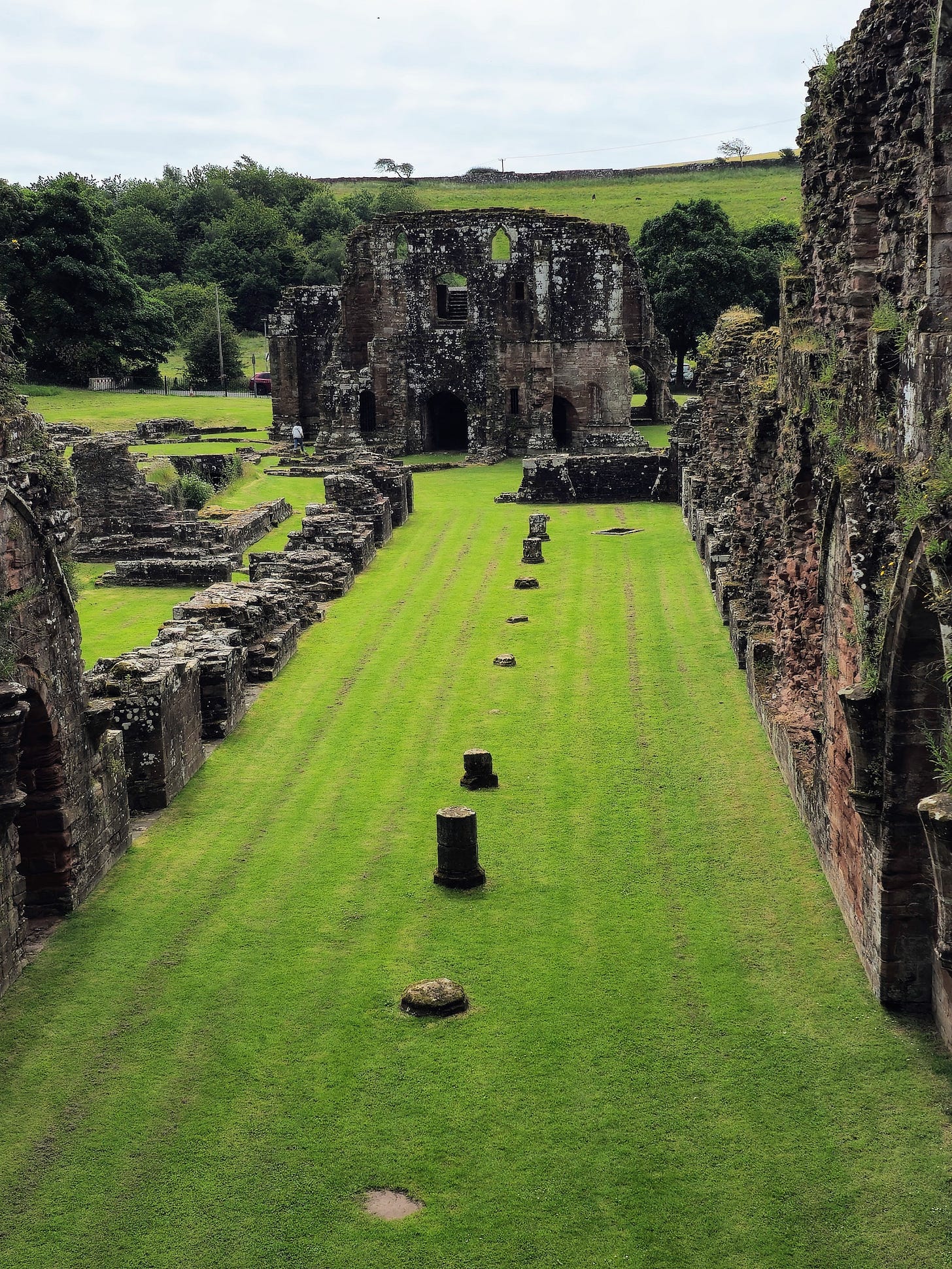Dissolution
At Furness Abbey
Dissolution is a powerful word, I thought, as I gazed on the ruins of Furness Abbey. In this case, the force behind it, backed by the full power of government, could still be felt after nearly 500 years.
As parliaments are dissolved, so are marriages. Chemicals dissolve, and people—most of us, anyway—fall into some kind of dissolution at times. Things fall apart, change shape, or break bonds. English history is full of dissolution in some form. But it’s the Dissolution of the Monasteries, which began in 1536, that has left the country dotted with reminders of dissolution through picturesque ruins like this one.
I entered the Abbey grounds via a narrow lane and an even narrower sandstone arch. It was a gentle summer morning, and the mild sunshine was just beginning to warm the stones outside as I entered the visitor centre. The woman who took my money and handed me my ticket told me nothing about the place. As I wandered about the entrance area, looking at the fallen statues and explanatory panels, however, I heard her explain to the next visitors, “This was a very rich place once, one of the richest abbeys, before Henry shut it down.” She seemed to speak with personal regret, as if her favourite restaurant had just been closed down by the local landowner.
I don't know why I didn’t get this this introduction from her. But I do know that as I read about the wealth of this place before it was dissolved in 1537, about the power the abbots had and their lack of accountability to the people of the land, I felt something like anger. What right had they, I thought, to set themselves up above their fellow citizens in the name of their religion? I’d always been on the side of Cromwell and the Reformation, ever since I’d studied the period at school.
I hurried out towards the ruins.
Outside, though, in the calm air and hushed surroundings of the grassy structures, my unspoken petulance subsided. I was free to let my mind roam among the old stones.
As historic ruins go, these are not all that old. These mostly date from the 12th & 13th centuries, and I'd seen older ones recently in Istanbul, Bath, and Stonehenge. But they have atmosphere, and the gaunt stone arches and walls stood out well against the lush green grass of June. It’s supposed to be haunted, of course; there’s a headless monk on horseback who sometimes rides underneath the sandstone arch. But there was no sign of him in the bright midsummer sun.
The information presented in the visitor centre gave some interesting details about the lives of the monks. As mentioned in a recent post by the wonderful Freya Rohn, a mediaeval monk's 'hour' was a division of the available amount of daylight, and summer 'hours' were therefore longer than winter ones. On an average summer day, the Cistercian monks who lived here would get up about 2am and go down into the church for the first of two services (Matins and Lauds). After that, the day mostly passed in manual work, eating, more prayers, and a short siesta. Any spare time was spent in private prayer, reading, or study. They’d apparently go to bed around 7.30pm.
I reflected on this impressively austere life of devotion as I wandered the grounds, but I was also amused to remember Browning’s less pious imagining of a monk’s life in his Soliloquy of the Spanish Cloister (1842). It begins,
Gr-r-r--there go, my heart's abhorrence!
And that sets the tone for what comes next. It’s a lively portrait of the monk who’s the object of the speaker’s scorn and hatred, as well as the speaker himself, with the latter clearly emerging as the less pious of the two. An indication of this poem’s power is that over 70 years later, it drew this comment from a Jesuit critic: “Coarse, vulgar, scurrilous, without any claim to rank as poetry.” Ouch.1
The poem reminds me that human intolerance, pettiness, and envy can occur in any community. And perhaps especially in one where people are thrown together and whose duty was to put up with each other’s foibles year after year.
The bigger lesson I reflected on as I strolled among the old buildings was equally obvious. Ruins such as this one, or indeed, almost any of the ruins I've mentioned above, serve as a reminder of the impermanence of all our human projects. The empires or dynasties we construct, the structures we build, and the systems we pursue all fail, fall, or disappear. Some that I’ve seen are still the source of mystery (like Stonehenge, Hattusha, or certain Mayan ruins). Others are repurposed by conquerors, as with the Hagia Sophia. And others become merely quaint, like Furness Abbey.
But all such sites slow the grip of political time enough for me to see beyond the latest election, the brewing scandal, or the pending economic crash. They take me into a calmer passage of time, where the pain of the current crisis is dulled by knowledge of its long line of predecessors. They also offer me the abstract comfort of the thought that all will dissolve and find another form, including myself, Thomas Cromwell, and the grumbling monk.
As I exited the site, I gave a final glance upwards at the old sandstone arch that, too, would crumble in time and delivered myself to the gathering roar of the Sunday lunchtime traffic outside.
I am indebted for this information to Carol Rumens' excellent analysis of the poem, here: https://www.theguardian.com/books/2016/may/09/poem-of-the-week-soliloquy-of-the-spanish-cloister-by-robert-browning








Your words and photos took me there. Like others here, I thought of Ozymandias. Churches were empire-builders, weren’t they? And the poem is a hoot.
A lovely meditation— poised between abstract and concrete. You’re wonderful at drawing poetry into your essays. It made me think of Ozymandias—